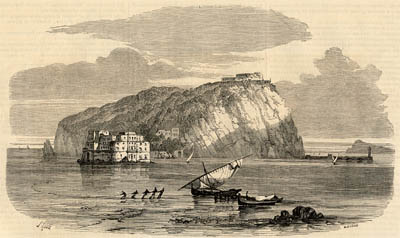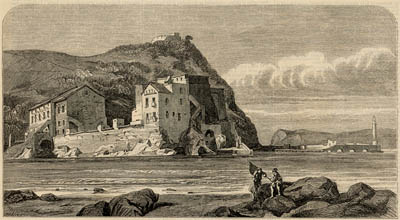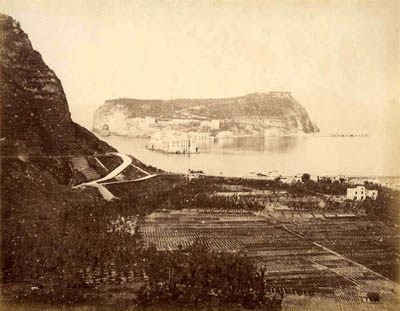![]()
This page is also available in French
![]()
Berlioz’s visit to the island of Nisida was one of the excursions with Virgilian associations which he made during his stay in Naples between 1 and 14 October 1831, the others being to Posilippo and ‘Virgil’s tomb’.
Nisida — which Berlioz sometimes calls Nisita — is a tiny island which blends into the foot of Mount Posilippo not very far from Naples. Berlioz made a short visit there, which can be dated precisely to October 7, 1831 from the passage in a letter to his family where he describes it that same day (CG no. 244):
[…] This morning I took leave of my companions and left for the island of Nisida. What a day!… I got up in a very melancholy frame of mind, full of that sadness experienced when you are a fourteen year old who believes in happiness, sees life through a poetic lens, sheds tears on reading the novels of Florian and is deeply affected by the sight of an old tower perched on a dark rock. I was rather tired on arriving at the bay of Baïa; that is where Nero prepared for his mother Agrippina a pleasure outing, from which she escaped by swimming away, to the great disappointment of her illustrious son. That is also where Virgil brought Aeneas ashore with his shattered fleet. I got on to a small boat by the seaside with four rowers, and they quickly brought me to Nisida, a delightful little island, covered with fruit trees, olives, oranges, figs and vines; tall, with a curious shape, clad with greenery, red and golden. On seeing it from a distance I was reminded of my Irish melody about the sunset and of ‘those happy isles hidden by golden veils’. I was expecting to be cruelly disappointed, and so was not surprised on reaching the summit to find there a prison for convicts and to hear the rattle of chains and the screams of prisoners instead of pastoral songs. […] As the wind was freshening, one of my sailors came to fetch me and I re-embarked. The waves were already strong and our nutshell with neither sails nor rigging felt like a dead leaf tossed on the waves; but we did manage to arrive back safely. […]
The description should be compared with the somewhat embellished account of the excursion which he gave later in his Memoirs and which differs in a number of details (chapter 41):
I was strolling nonchalantly along the shore, moved at the thought of poor Tasso, whose modest tomb I had visited with Mendelssohn a few months earlier in Rome at the convent of Sant’Onofrio, and absorbed in reflections on the misfortune of poets who are poets of the heart, etc. etc. All of a sudden Tasso makes me think of Cervantes, Cervantes of his charming pastorale Galatea, Galatea of the delightful figure named Nisida who shines next to her in the novel, Nisida of the island in the Bay of Pozzuoli which bears that charming name, and I am seized unexpectedly with an irresistible desire to visit it.
I rush there, and presently I am in Posilippo Cave. I rush out, still at the double, reach the shore, spot a boat and want to hire it. I ask for four rowers, six come forward. I offer them a decent price, pointing out that I did not need six rowers to sail across to Nisida in a cockleshell. They insist with a smile and ask me about thirty francs for a journey which was worth five at most. I was in good spirits; two young lads were standing nearby without saying a word and looking envious. I thought the pretensions of my rowers were outrageous and laughable, and pointing to the two lazzaronetti:
« — All right, thirty francs, but all eight of you jump in and let us row with a will. »
Shouts of delight, young and old all leap for joy. We jump into the boat and reach Nisida in a few minutes. Leaving my ship in the care of the crew, I go up to the island, criss-cross it in every direction, and watch the sun setting behind Cape Misenum that the poetry of the Aeneid has made famous. The sea, meanwhile, oblivious of Virgil, Aeneas, Ascanius, Misenum, and Palinurus, shimmers with countless reflections in a major key.
As I was drifting around with no fixed purpose a soldier speaking decent French comes up and volunteers to show me around the various features of the island, the best viewpoints, etc. I gladly accept his offer. After an hour I take my leave and reach for my purse to give him the usual buona mano, but he steps back looking almost offended, and rejects my offer saying:
« — Sir, what are you doing? I ask you nothing, … except… to pray to God for me.
— Of course I will, I say to myself as I put my purse back in my pocket, what a funny idea, and I’ll be damned if I fail. »
That evening, while going to bed, I recited in all seriousness a first Pater for my good sergeant, but the second time round I burst out laughing. I very much fear the good fellow has not struck gold and must have remained sergeant as before.
I would probably have stayed in Nisida till the next day had one of my sailors not been delegated by the captain to come and hail me, and warn that as the wind was freshening we would have trouble rejoining the mainland if we did not weigh anchor and set sail without delay. I follow this wise advice and walk down. We all resume our positions on the ship […].
Berlioz remembered fondly his brief visit to the island, as can be seen from a digression in one of his feuilletons (Journal des Débats, 21 May 1840).
![]()
All the pictures on this page have been scanned from a photo and two publications in our own collection. © Monir Tayeb and Michel Austin. All rights of reproduction reserved.

The above engraving was published in L’Univers Illustré in 1861 (page 132) – a subscriber to the journal had sent it to the editor who subsequently published it in the paper.

The above engraving was published in the Illustrated Times on 1 November 1856 (page 296).

The above photo was taken by the renowned photographer Giorgio Sommer (1834-1914).
© Michel Austin and Monir Tayeb for the pictures and information on this page. All rights of reproduction reserved.
Copyright notice: The texts, photos, images and musical scores on all pages of this site are covered by UK Law and International Law. All rights of publication or reproduction of this material in any form, including Web page use, are reserved. Their use without our explicit permission is illegal.